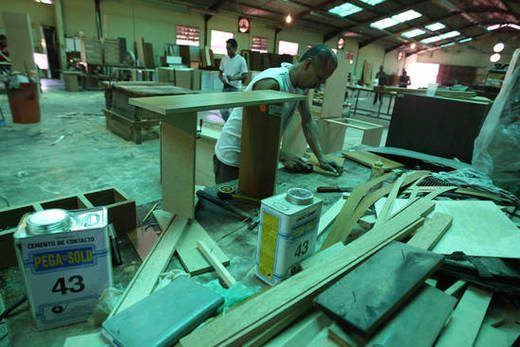
TODAY VENEZUELA – Venezuelan industries find themselves in a “desperate struggle for survival” says the President of Venezuelan Confederation of industrial (Conindustria), Juan Pablo Olalquiaga. But, despite adversity, the country’s manufacturing sector “is determined to move forward to maintain production and preserve jobs”.
Since 1999 – the year when the current regime came to power -the industrial sector in Venezuela “has been falling slowly but steadily, heading toward a virtual standstill,” for a variety of reasons, says Olalquiaga. In 1998 the manufacturing sector’s share of the gross domestic product (GDP) stood at 17.4%; in 2012 it fell to 13.9%; in 2013 it stood at 13.7%; and in the third quarter of 2014 at 13.4%, according to figures provided by Conindustria. If corrective actions are not implemented to address all of the failure causes “all the jobs in the industrial sector are at risk of being lost,” says Olalquiaga.
According to official figures from the National Statistics Institute (INE), there were at least 11,117 industrial facilities in full production in Venezuela at the end of 1998, employing 449,636 workers. By 2007 the number of industries dropped to 7,093 and employment declined to 345,168.
Government takeover of domestic and foreign companies has been on the rise since 1999. Some companies were transferred to state ownership through the purchase of assets, but in the majority of cases measures such as expropriation, plundering, nationalization and takeover were applied. According to Conindustria figures, 1,322 cases of government takeovers were recorded between 2002 and 2015, 416 of which in the industrial sector.
Comprehensive statistics on the Venezuelan industrial sector have not been available since 2007, but the trend towards a reduction of industries has continued unabated, says Olalquiaga.
Between 2007 and 2010, 130 major industries were operating in different areas, according to the Large Industrial Companies Survey 2007-2010 published by the INE in March 2012. The survey notes that “the corporations’ payroll rose every year from 125,600 staff in 2007 to 134,600 in 2010, accounting for an increase of 7.2%”. Six sectors increased their payroll, “most notably food, beverages and tobacco with an increase of 6,100 staff; and the base metals and processed metal articles sector, hiring 2,000 additional workers.” Payroll was reduced in two sectors, particularly in the automotive sector, with a reduction of 1,900 staff.
In recent years the automotive industry has seen a dramatic drop in production. According to the latest report (2014) by the Venezuelan Automotive Chamber (Cavenez), car manufacturing plunged to 72.46%between January and December 2014, when only 19,759 units were assembled, compared to 71,753 in 2013.
In another study prepared by the INE, entitled Qualitative Industrial survey for the 4th quarter of 2013,businesspersons in the manufacturing sector were of the view that, with respect to the previous quarter of that year, the economic and productive situation of the industry was worse, and the number of staff employed was considerably less.
The situation in figures
According to the Situation Survey for the second quarter of 2015 (II Encuesta de Coyuntura Trimestral 2015), conducted by Conindustria last July, the Venezuelan industries operated at 48.3% of their installed capacity at the second quarter of 2015. While large firms ran at 57.5% of their actual capacity, medium-sized and small companies operated at44.3% of capacity.
The survey found that, compared with the same period of 2014, during the second quarter of 2015 the level of production of the industrial park decreased 50%on average. Regarding jobs, the survey found that the level of employment decreased from 28% to 55% depending on the industry. The most affected sectors were paper and paperboard, non-metallic minerals and textiles; while the least impacted were base metals, chemicals, food, processed metal articles and wood and furniture.
Nationalized companies have also reduced their production capacity over the past years, incurring significant financial losses. The executive branch itself has repeatedly acknowledged – via the management reports from the ministries – that industries in state hands operate at a loss, especially in the aluminum, steel and cement sectors.
In the aluminum sector, industries such as Alcasa, Bauxilum, Carbonorca and Venalum operated to one-third of their capacity in 2014 (to the levels of thirty years back).
Last year Alcasa produced only 28,798 metric tons of aluminum when it actually has the capacity to produce 170,000 tons. Venalum, for its part, produced 109,536 metric tons (14% less than in 2013), according to government data.
The situation is not far different in the steel sector. Production of Siderúrgica del Orinoco (Sidor) dropped at least 30% in 2014, incurring a loss of VEB 7.6 billion.
Similar results are recorded in the cement industry. The Fábrica Nacional de Cementos company is a case in point. It went from 784,000 tons of cement in 2013 to 432,000 in 2014, accounting for a 30% drop.
Restrictive factors
The Situation Survey for the Second Quarter of 2015 conducted by Conindustria points to the manifold factors that impede the attainment of increased production, the most significant being the lack of raw materials both national and imported, delays in foreign currency purchase obligations, political uncertainty and price controls.
There are further factors that impede progress, namely constant power outages, low demand, lack of machinery and equipment, financial constraints, a loss of skilled workers due to the increasing numbers of highly skilled migrants, labor disputes and work absenteeism, and competition with imported products.
Olalquiaga says that any industrial company is based on two fundamental aspects–namely, its ability to maintain its operations and its ability to plan ahead to adapt to future changes. In his view, both aspects are now seriously compromised.
Regarding the ability to maintain operations, Olalquiaga says that Venezuela’s industries are “at risk of total paralysis” due to lack of raw material.
According to the Situation Survey, the level of inventory of raw materials during the second quarter of 2015 dropped by a bit over 60%, the most affected being small industries, whose level declined by about 71; the medium-sized industry decreased by at least 68% and the big industry by 45%.
The Qualitative Industrial Survey conducted by the INE in the fourth quarter of 2013 also found that the volume of imported raw materials acquired during the period under study was less than that of the of the previous quarter, while the proportion of domestic raw material remained the same.
Olalquiaga said that some industries have stopped operation due to the lack of raw materials, both imported and domestic, while other industries still in operation have had to halt some production lines, with some lines intermittently operating, like the tuna cannery of Empresas Polar, located in Sucre State (east).
Olalquiaga says that in the case of imported raw materials, the situation is very serious because of the delays in foreign currency purchase and loss of confidence by creditors. In terms of domestic raw materials, in many cases the main providers are government-owned companies, which are also working at a fraction of their capacity. Such is the case, for example, of Sidor, which produced 1 million metric tons of steel in 2014, compared to 1.4 million in 2013.
“This is why everything depending on that steel, required for the manufacture of all metal mechanical products, is severely limited. The same is true for the entire petrochemical industry,” Olalquiaga says.
And he adds that the production level of industries has been greatly diminished and is in constant decline, which has caused the manufacturing sector to reduce product ranges.
Olalquiaga also notes that, in order for the industrial sector to be fully operational, it must maintain active networking with other sub-sectors that provide it with feed stock to operate, but these sub-sectors are also operating at a low level because they face the same difficulties as the rest of the companies in the country.
With regard to future planning, Olalquiaga says that the executive branch has not come up with a plan to remedy the situation, and that there is no dialogue between government representatives and all major stakeholders, as the government has not responded to a request for such a dialogue.
According to Olalquiaga, industries in the country are in the grips of a “slow death throe.” If the companies remain in business it is because of their natural instinct for survival, he says. However, he points out that this cannot be sustained indefinitely if the distortions of the economy are not corrected. Conindustria proposes five solutions for immediate application to try and stop the total collapse of the sector: the securitization of debt; the legalization of a parallel market; the replacement of price controls with direct subsidies; the transfer to private sector of companies that are in government hands; and allowing industries to directly contract with research centers and institutes at the universities.













